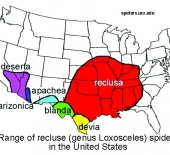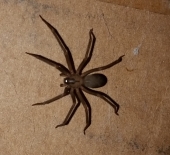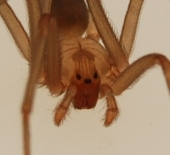The brown recluse is about 3/8 of an inch in body length, and has a uniformly colored abdomen that can vary from cream to dark brown depending on diet. It has a dark brown violin shape on the cephalothorax, which is the portion of the body to which the legs are attached. The neck of the violin points toward the abdomen. The main identifying feature that you should look at is the eye pattern consisting of six eyes in pairs with a space separating the pairs. Most spiders have eight eyes in two rows of four. There are no spines on the legs, only fine hairs.
Brown Recluse Spiders make small retreat webs behind objects, never out in the open. In their native habitat in the Midwestern U.S., they are found in buildings and outbuildings, especially in boxes and among papers. They can be found in almost any place which had remained undisturbed for lengthy periods of time, such as behind pictures, furniture, in boxes of toys, in clothing, among stored papers, in the corrugations of cardboard boxes, and in discarded articles, such as tires, inner tubes, and assorted other junk. Most of the specimens found outdoors are under rocks, especially in bluff outcrops or under bark or inside logs. They seem to prefer dry conditions.
All
Loxosceles spiders, including two found in southern California , the Chilean Brown Recluse Spider
(L. laeta) and the native Desert Recluse Spiders (
L. deserta), have a venom component that is capable of causing necrotic skin lesions. However, 60% of “Brown Recluse spider bite” diagnoses in California came from the areas where no
Loxosceles spiders were known to exist. The uncommon misdiagnoses of Brown Recluse spider bites and the actual public health risk of this spider is yet to be determined.
Again, we emphasize that these spiders are not established in Alameda County, though through interstate shipment of goods and travel, it is possible that these spiders are brought into our state on a regular basis. Their establishment seems to have been prevented due to a variety of reasons, including environmental incompatibility and competition with other native spiders. Any suspected Brown Recluse spider should be submitted to us for identification.
Control of brown recluse spiders is similar to other spider control measures:
- Monitor the corners, ceiling, and door jams for the web sac and vacuum immediately if found.
- Avoid leaving your porch light on at night, or use a motion detector sensor. A night-light will attract insects which attract spiders.
- Keep plants back from the perimeter of your living structure. Plants provide food for insects, which are food for spiders. When plants rest against the side of your home, it provides access for spiders to climb into your home.
- A clear open area will reduce the attractiveness to spiders. Remove debris and vegetation that provides shelter for spiders.
- Keep window and door screens in good repair.
- A monthly rinsing of eaves, windows, and doors will help reduce spider populations on the exterior of your home.
- An effective way to remove an unwanted spider from your home is to vacuum it up with the hose and wand attachment.
- Locating and removing eggs sacs will reduce future spider populations.
- The use of pesticides can aide in spider control. Use only chemicals registered for spiders. The standard treatment is around windows and doors, under eaves and along the foundation of the home.






